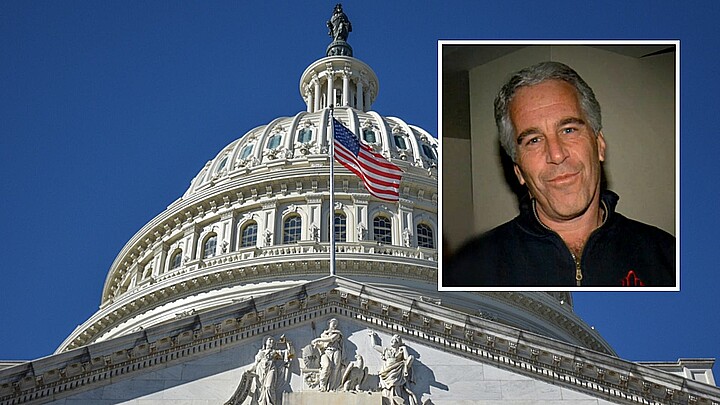Politics
Special Report: Latino youth vote comes into focus after Democrats sweep Gen Z vote
While abortion, the economy and personal rights came into focus for many young people, Latino youth may also be focused Hispanic American centered issues such as rising crime, civil liberties and how inflation has specifically impacted their community
December 5, 2022 9:07am
Updated: December 5, 2022 5:06pm
As Republicans continue to grapple with a devastating loss among young adults from the 2022 midterm elections, some statistics suggest the GOP has an opportunity to pick up some traction with the Latino youth vote as their concerns could grow with age about crime, inflation and civil liberties.
One million young Hispanic Americans are expected to turn 18 every year for the next 15 years, according to the Pew Research Center, making Hispanic American youth a key target demographic for both parties as a million new eligible voters will be borne from the group each year for the next decade and a half.
Numbers don’t lie: Democrats conquered the youth vote in 2022
Tufts University’s Tisch College of Civic Life, one of the most dogged trackers of young voters, reported last month that 27% of 18-to-29 voters cast ballots in midterm elections, and that 63% of them voted Democratic in House elections.
“Democrats would have gotten crushed without young voter support,” reported CNN’s Harry Enten in a Nov. 12 analysis. “Democratic House candidates won voters under the age of 45 by 13 points, while losing voters ages 45 and older by 10 points. Breaking it down further, House Democratic candidates won voters under 30 by 28 points – that’s an increase from their 26-point edge with this group two years ago.”
Among the key issues Gen Z voters were attracted to were the Democrats positions on abortion, climate change and firearm rights, reported the New York Times in November.
“Political analysts said that young people were attracted to the Democratic side by its position on issues they consider crucial: abortion, climate change and gun rights among them. President Biden’s deftly timed decision this fall to forgive a share of student loan debt – since halted by court rulings – also could not have hurt,” the Times’ Dan Simmons and Michael Wines wrote.
Aging Millennial Obama supporters now facing economic hardship are defecting
Despite these hurdles, there may be hope for Republicans who aren’t ready to wave the white flag with Gen Z voters who constitute anyone born after 1996. For starters, those millennials who were once avid supporters of President Democratic Obama are now starting to defect from the Democratic Party raising questions as to whether the turn is an anomaly or the start of a trend.
One fact evidencing this trend is the further breakdown within the Millennial age span. While younger Millennials mostly remained loyal to the Democratic Party, aging Millennials creeping up on 40 demonstrated a change of heart during the lockdown at the peak of the pandemic that continues today.
“This recession steamrolled younger workers just as Millennials were entering their prime working years – the oldest Millennials are nearing 40 while the youngest are in their mid-20s. Millennial employment plunged by 16 percent in March and April this year, our calculations show,” wrote the Washington Post in June 2020 in an article titled, ‘The unluckiest generation in U.S. history.”
Two years later in July (2022), the New York Times conceded that “now that Millennials are in their 30s, a point when many of their parents were able to own homes, they’re squeezed between the worst inflation rates of their lifetimes, eye-watering housing prices and the precarious fallout of the pandemic.”
The economic problems haunting most young people most likely is not going away any time soon. According to an October U.S. Treasury Report the national debt surpassed $31 trillion, and a recent September report from the Committee for a Responsible Federal Budget (CRFB)reports that while the Trump administration “appropriately enacted $3.4 trillion of additional borrowing to help fight the pandemic and stabilize the economy… once the economy was strong enough, Congress and the White House should have stopped engaging in new borrowing…”
As a result, the national debt has arguably become a generational issue as each American born hypothetically has about $50,000 of national debt. While that debt isn’t literally repaid by each individual, it has a collective impact on the state of the union leading to rising interest rates and a reduction in the Gross National Product. According to the CRFB, the GNP will increase 1% after 10 years, 2% after 20 years and 6% after 30 years.”
“It took this nation 200 years to pile up its firs trillion dollars in national debt, and since the pandemic we have been adding at the rate of $1 trillion nearly every quarter,” Loyola Marymount Economic Professor Sung Wan Sohn told the Associated Press in October. “When you increase government spending and money supply, you will pay the price later.”
The optics for this may not fare well for Democrats in the future since as of September 2022 the Biden administration has approved $4.8 trillion in new deficit spending, reports CRFB.
It’s not just the economy, stupid. It’s abortion and personal rights…
Exit polls indicate that while the economy remains a significant issue for most—including Hispanic Americans, 49% of young voters actually named abortion as their top issue.
“Among young voters of both genders surveyed in Edison exit polls, 80% favored legal abortions, and 49% named abortion as the issue that sealed their vote. Sixty-two percent of women under 45 listed abortion as their top issue,” wrote Daniel De Vise in a Nov. 14 edition of The Hill.
That assertion was borne out in a study conducted at Harvard, according to Alan Zhang of the Harvard Public Opinion Project.
“Young voters cancel out every single vote of those over 65. Under 30 and over 40 were the only age group to go to the Democrats and they went overwhelmingly to the Democrats,” Zhang told ABC News in a Nov. 16 interview. Without the youth vote, there was no firewall that stopped the ‘red wave’ from taking over… What we found heading into the midterms was that at the top of mind for a lot of young voters was the economy and inflation, but in addition to that [were] also issues like abortion and protecting democracy and protecting their rights.
According to Tufts University Tisch College, the following age groups prioritized abortion, crime, gun policy and immigration.
Forty four percent of voters ages 18-29 prioritized abortion while 21% prioritized inflation, 13% crime, 9% gun policy and 7% abortion. But for voters 30-44, only 34% of voters prioritized inflation with only 31% prioritizing abortion with 13% gun rights, 8% crime and 6% immigration.
Thirty three percent of voters from 41-64 ranked inflation their highest priority with 24% prioritizing abortion, 12% crime, 12% immigration and 10% gun policy. The oldest category of voters 65 and above ranked inflation as their highest concern with 32% in their camp, 22% prioritizing abortion, 13% crime, and 12% equally prioritizing gun policy and immigration.
Latino priorities and Latino youth
Young Hispanic Americans were an important voting group in 2022 midterm elections, and may have helped Democrats slow down the much anticipated red wave.
Republicans took the House by a slim margin of only nine seats and missed the Senate by one or two races (depending on the upcoming Senate runoff in Georgia), and data suggests that while conservatives are making gains with Hispanics, it isn’t as much as Republicans have hoped.
Exit polling suggests that young Latino voters did not always consistently with their party identification. An NBC News exit poll found that 68% of Latino voters under 30 voted for a Democratic House candidate on Election Day while only 43% of them actually identify as Democrats and 41% as liberal. A CNN poll found similar results.
According to the NBC report, 20% of young Latinos identify as Republican and 25% as conservative with 37% identifying as independent.
Another analysis conducted by Tufts, CIRCLE—the Center for Information and & Research on Civic Learning and Engagement, young Hispanic American voters under the age of 30 gave more support to Democrats on Election Day compared to young white voters. While 68% of young Latinos voted Democratic, only 58% of young white voters did the same.
“In close races, the big margins from young people, from youth of color, from young Latinos, can be really influential. Sometimes they can even be decisive,” CIRCLE’s communications lead Alberto Medina told NBC News. “They can really either put a candidate over the top or keep them in the race.”
As an example, NBC cited Senate races in southwest states such as Arizona and Nevada, where young Latinos make up 40% of all newly eligible voters in the region. CIRCLE ranked these races as ones where young voters could have the biggest impact.
“The ranking for those two states is really heavily influenced by the big presence of young Latino voters,” Medina said.
This fact may have been instrumental in helping Sen. Catherine Masto Cortez edge out Republican opponent Adam Laxalt despite early projections he was ahead.
While a Brookings report says Latinos supported Democrats on a margin of about 2-1 in both House and Senate races in the 2022 midterm elections, there are key areas where Republicans can make a dent.
“Latinos’ support for Democratic House candidates decreased by 5% from 2020, but the movement toward the GOP was not as pronounced as pre-election surveys suggested it might be this cycle,” wrote Gabriel Sanchez in a Nov. 11 Brookings report. “This analysis points to a small but consistent shift among Latinos toward the Republican Party across most sub-groups of the overall Latino electorate… Latinas were a key sub-group of the Latino electorate whose movement toward the Republican Party was noticeable over time.
“Latinas were twice as likely to indicate that the most important issue driving their voting decision this cycle was women’s reproductive health and abortion relative to Latino men, with 16% of Latinas across the country noting that this was the most important issue that candidate pick for their congressional district. Conversely, Latino men were twice as likely to indicate that they “always vote Republican” in congressional races relative to Latinas (17% for Latino men and 9% for Latinas). The survey numbers suggest that the Democrats’ focus on access to abortion helped stall the movement toward the GOP among Latinas.”
While reproductive health stalled the Republican red wave, consistent polling has shown that Hispanic Americans take issues such as inflation, violent crime, immigration, and personal liberties to heart. They are also seeking bipartisan candidates that they feel can pull the country together, signaling hope for more moderate GOP candidates that gravitate toward the center.
Issues involving personal freedom have proven to be a significant issue especially for Latinos who fled from communist countries such as Cuba, Nicaragua and Venezuela or left neighboring countries amid the current “pink tide” as other countries such as Chile, Colombia and Peru elect socialist leaders.
Whether or not that impact carries from one generation to another to effect how Gen Z voters cast their ballots in 2024 remains to be seen.











